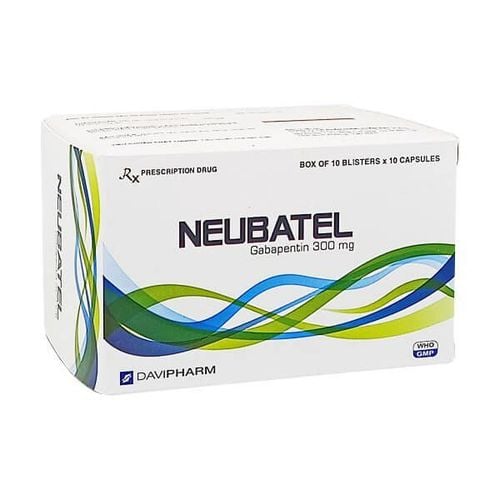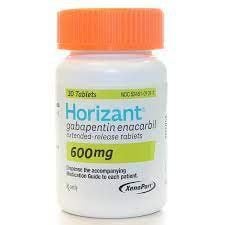This is an automatically translated article.
Neuronstad is an antiepileptic drug, used to relieve partial seizures and relieve symptoms of neuropathic pain. Let's learn more about the drug through the article below.
1. What are the uses of Neuronstad?
The main ingredient of Neuronstad is Gabapentin 300mg, with the dosage form being capsules.
Gabapentin is an antiepileptic drug, the mechanism of which is not really clear. The chemical structure of gabapentin is similar to that of the neurotransmitter gamma-aminobutyric acid (GABA), but gabapentin does not act directly on GABA receptors and does not alter its structure, release, or metabolism. and GABA recovery.
After oral administration of Gabapentin absorbed from the gastrointestinal tract, the drug reached peak plasma concentrations 2 hours after oral administration and reached stable plasma concentrations after 1–2 days. When absorbed Gabapentin will be distributed throughout the body, into breast milk and Gabapentin is almost not metabolized in the body. The drug is then eliminated mainly by the kidneys as unchanged drug. The half-life of gabapentin averages about 5–7 hours in subjects with normal renal function. In elderly patients and in patients with impaired renal function, gabapentin clearance is reduced.
2. Indications and contraindications of Neuronstad
Indications:
Neuronstad is indicated in the following cases:
Adjuvant treatment in partial epilepsy. Treatment of pain caused by nerve causes such as inflammation of the peripheral nerves, sciatica, pain after shingles. Contraindications:
Neuronstad drug should not be used in the following cases: Hypersensitivity to gabapentin or hypersensitivity to any component of the drug.
3. Dosage and usage of Neuronstad
How to use:
The drug is taken orally. The time to take the drug does not depend on the meal, because almost food does not affect absorption. Dosage:
In case of epilepsy:
Adults and children > 12 years old: The first day take 300 mg x 1 time. On the second day, take 300 mg/time x 2 times. On the third day, take 300 mg/time x 3 times. The dose may then be increased in increments of 300 mg/day, based on the patient's response and tolerability until an effective therapeutic dose is reached, the usual dose being 900–1800 mg/day. divided 3 times. Note that the maximum is not more than 2400 mg/day. Should be used more than once, the interval should not exceed 12 hours. When used in high doses can be divided into 4 times / day. For patients with renal impairment : Appropriate dose adjustment based on creatinine clearance is recommended as follows:
Creatinine clearance 50-70 mL/min administered at a dose of 600–1200 mg/day in 3 divided doses time. Creatinine clearance 30-49 mL/min administered at doses ranging from 300-600 mg/day in 3 divided doses. Creatinine clearance 15-29 mL/min administered at a dose of 300 mg/day in 3 divided doses. Creatinine clearance less than 15 mL/min administered at a dose of 300 mg every other day in 3 divided doses. Hemodialysis: Initial dose is 300-400mg, then 200-300mg every 4 hours of hemodialysis Children 6–12 years old or children weighing 30–36kg: First day 300 mg x 1 time/ day. The second day use 300 mg x 2 times / day. The third day 300mg x 3 times/day. The usual dose for children is 300 mg/time x 3 times/day. Some children who can't tolerate daily increments need to extend the increments by approximately every week. Children under 12 years of age: There is no evaluation of the use of Neuronstad in children under 12 years of age with impaired renal function. Treatment of pain due to nerve causes:
Adults: Take not more than 1800 mg/day and divided into 3 times. Or another way can be used is to gradually increase the dose as follows: The first day use 300 mg; The second day use 300 mg / time x 2 times / day; The third day use 300 mg / time x 3 times / day. Further increase depending on response and tolerance, can be used up to a maximum dose of 1800 mg/day in 3 divided doses. Elderly: When used, the dose should be adjusted due to decreased renal function. Overdose and missed dose:
Overdose: Can occur and cause symptoms such as side effects Most of the cases of patients with overdose recover after the use of supportive measures. Drugs can be removed from the body by hemodialysis. Missed dose: If you forget a dose, take it as soon as you remember. However, if you remember that it is almost time for your next dose, skip the missed dose and continue taking your next dose at the usual time.
4. Neuronstad side effects
When using Neuronstad, you may experience unwanted effects:
Common side effects:
Nervous: Loss of coordination in movement, nystagmus, feeling tired , dizziness, edema, drowsiness, memory impairment. For children under 12 years old: There may be neurological problems such as anxiety, behavioral changes such as fussiness, feelings of euphoria or depression, overstimulation, oppositional attitudes.. Digestive: Feeling of indigestion, dry mouth, constipation, abdominal pain, diarrhea. Peripheral angioedema may also occur. Respiratory: Rhinitis, pharyngitis, pneumonia. Eyes: Double vision, reduced vision. Musculoskeletal: Muscle pain, joint pain. Skin: Rash, skin rash. Other: Leukopenia, impotence. When experiencing side effects of the drug, you need to stop using and notify your doctor or immediately go to the nearest medical facility for timely treatment.
5. Things to note when taking Neuronstad
Before using the drug, tell your doctor about your medical history and allergy history.
Use caution when using the drug for the following subjects:
For people with a history of mental disorders, people with impaired kidney function and hemodialysis. For drivers and operators of machines: Gabapentin has effects on the central nervous system and may cause drowsiness, dizziness or other similar symptoms. These symptoms affect the driver and can also be potentially dangerous. This is especially common at the start of treatment and after the patient has increased the dose. Pregnancy: Gabapentin is teratogenic in rodents. However, there are no adequate studies in pregnant women. However, Neuronstad should only be used during pregnancy when clearly needed and when the benefits outweigh the risks to the fetus. Lactation: Gabapentin can pass into breast milk when taken orally. But the effect of the drug on the neonate is still unknown, so gabapentin should only be used in nursing women when absolutely necessary, should stop breastfeeding when taking the drug to ensure safety. The drug may cause a false positive in proteinuria in patients taking gabapentin. Neuronstad should not be stopped suddenly, as that may increase the frequency of seizures. Before stopping this drug or switching to another antiepileptic drug, the dose should be reduced for at least 7 days. Drug interactions: Antacids reduce the bioavailability of gabapentin by about 20% by affecting drug absorption. Gabapentin must be administered at least 2 hours after the antacid. Above is information about Neuronstad drug. This drug is a prescription drug, so you only use it when prescribed and if there is something you do not understand, you can ask the treating doctor directly.
Please dial HOTLINE for more information or register for an appointment HERE. Download MyVinmec app to make appointments faster and to manage your bookings easily.













